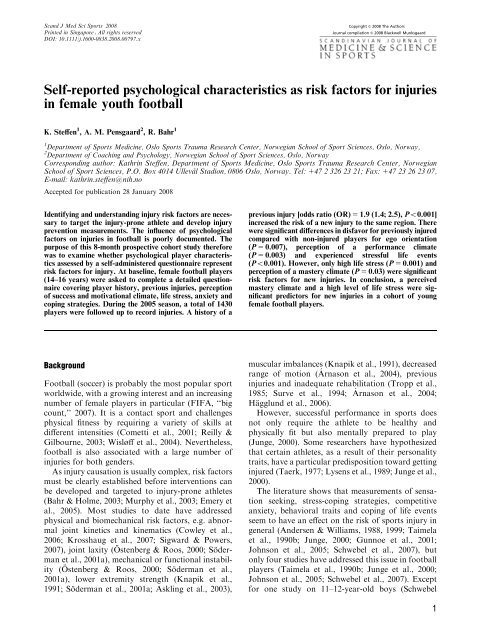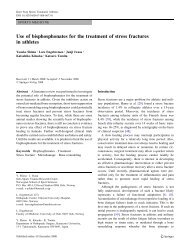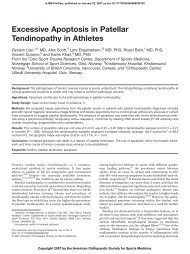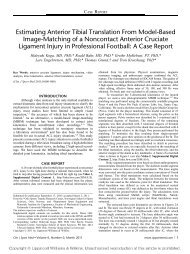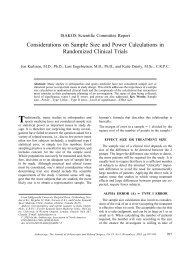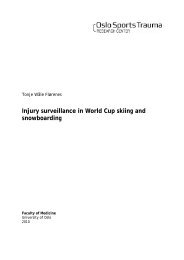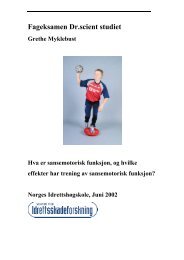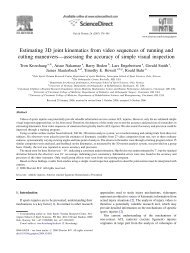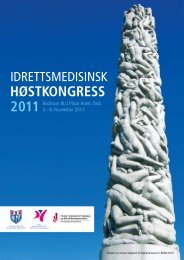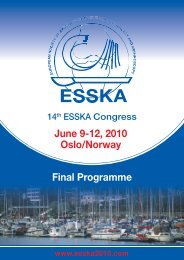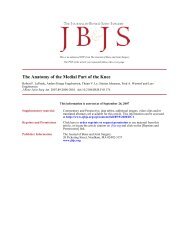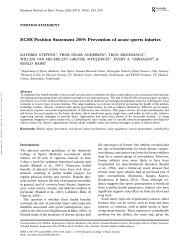Self-reported psychological characteristics as risk factors for injuries ...
Self-reported psychological characteristics as risk factors for injuries ...
Self-reported psychological characteristics as risk factors for injuries ...
You also want an ePaper? Increase the reach of your titles
YUMPU automatically turns print PDFs into web optimized ePapers that Google loves.
Scand J Med Sci Sports 2008Printed in Singapore . All rights reservedDOI: 10.1111/j.1600-0838.2008.00797.xCopyright & 2008 The AuthorsJournal compilation & 2008 Blackwell Munksgaard<strong>Self</strong>-<strong>reported</strong> <strong>psychological</strong> <strong>characteristics</strong> <strong>as</strong> <strong>risk</strong> <strong>factors</strong> <strong>for</strong> <strong>injuries</strong>in female youth footballK. Steffen 1 , A. M. Pensgaard 2 , R. Bahr 11 Department of Sports Medicine, Oslo Sports Trauma Research Center, Norwegian School of Sport Sciences, Oslo, Norway,2 Department of Coaching and Psychology, Norwegian School of Sport Sciences, Oslo, NorwayCorresponding author: Kathrin Steffen, Department of Sports Medicine, Oslo Sports Trauma Research Center, NorwegianSchool of Sport Sciences, P.O. Box 4014 Ulleva˚l Stadion, 0806 Oslo, Norway. Tel: 147 2 326 23 21; Fax: 147 23 26 23 07,E-mail: kathrin.steffen@nih.noAccepted <strong>for</strong> publication 28 January 2008Identifying and understanding injury <strong>risk</strong> <strong>factors</strong> are necessaryto target the injury-prone athlete and develop injuryprevention me<strong>as</strong>urements. The influence of <strong>psychological</strong><strong>factors</strong> on <strong>injuries</strong> in football is poorly documented. Thepurpose of this 8-month prospective cohort study there<strong>for</strong>ew<strong>as</strong> to examine whether <strong>psychological</strong> player <strong>characteristics</strong><strong>as</strong>sessed by a self-administered questionnaire represent<strong>risk</strong> <strong>factors</strong> <strong>for</strong> injury. At b<strong>as</strong>eline, female football players(14–16 years) were <strong>as</strong>ked to complete a detailed questionnairecovering player history, previous <strong>injuries</strong>, perceptionof success and motivational climate, life stress, anxiety andcoping strategies. During the 2005 se<strong>as</strong>on, a total of 1430players were followed up to record <strong>injuries</strong>. A history of aprevious injury [odds ratio (OR) 5 1.9 (1.4; 2.5), Po0.001]incre<strong>as</strong>ed the <strong>risk</strong> of a new injury to the same region. Therewere significant differences in disfavor <strong>for</strong> previously injuredcompared with non-injured players <strong>for</strong> ego orientation(P 5 0.007), perception of a per<strong>for</strong>mance climate(P 5 0.003) and experienced stressful life events(Po0.001). However, only high life stress (P 5 0.001) andperception of a m<strong>as</strong>tery climate (P 5 0.03) were significant<strong>risk</strong> <strong>factors</strong> <strong>for</strong> new <strong>injuries</strong>. In conclusion, a perceivedm<strong>as</strong>tery climate and a high level of life stress were significantpredictors <strong>for</strong> new <strong>injuries</strong> in a cohort of youngfemale football players.BackgroundFootball (soccer) is probably the most popular sportworldwide, with a growing interest and an incre<strong>as</strong>ingnumber of female players in particular (FIFA, ‘‘bigcount,’’ 2007). It is a contact sport and challengesphysical fitness by requiring a variety of skills atdifferent intensities (Cometti et al., 2001; Reilly &Gilbourne, 2003; Wisløff et al., 2004). Nevertheless,football is also <strong>as</strong>sociated with a large number of<strong>injuries</strong> <strong>for</strong> both genders.As injury causation is usually complex, <strong>risk</strong> <strong>factors</strong>must be clearly established be<strong>for</strong>e interventions canbe developed and targeted to injury-prone athletes(Bahr & Holme, 2003; Murphy et al., 2003; Emery etal., 2005). Most studies to date have addressedphysical and biomechanical <strong>risk</strong> <strong>factors</strong>, e.g. abnormaljoint kinetics and kinematics (Cowley et al.,2006; Krosshaug et al., 2007; Sigward & Powers,2007), joint laxity (O¨ stenberg & Roos, 2000; So¨ dermanet al., 2001a), mechanical or functional instability(O¨ stenberg & Roos, 2000; So¨ derman et al.,2001a), lower extremity strength (Knapik et al.,1991; So¨ derman et al., 2001a; Askling et al., 2003),muscular imbalances (Knapik et al., 1991), decre<strong>as</strong>edrange of motion (A´ rn<strong>as</strong>on et al., 2004), previous<strong>injuries</strong> and inadequate rehabilitation (Tropp et al.,1985; Surve et al., 1994; A´ rn<strong>as</strong>on et al., 2004;Hägglund et al., 2006).However, successful per<strong>for</strong>mance in sports doesnot only require the athlete to be healthy andphysically fit but also mentally prepared to play(Junge, 2000). Some researchers have hypothesizedthat certain athletes, <strong>as</strong> a result of their personalitytraits, have a particular predisposition toward gettinginjured (Taerk, 1977; Lysens et al., 1989; Junge et al.,2000).The literature shows that me<strong>as</strong>urements of sensationseeking, stress-coping strategies, competitiveanxiety, behavioral traits and coping of life eventsseem to have an effect on the <strong>risk</strong> of sports injury ingeneral (Andersen & Williams, 1988, 1999; Taimelaet al., 1990b; Junge, 2000; Gunnoe et al., 2001;Johnson et al., 2005; Schwebel et al., 2007), butonly four studies have addressed this issue in footballplayers (Taimela et al., 1990b; Junge et al., 2000;Johnson et al., 2005; Schwebel et al., 2007). Except<strong>for</strong> one study on 11–12-year-old boys (Schwebel1
Psychological <strong>risk</strong> <strong>factors</strong> <strong>for</strong> <strong>injuries</strong>hamsen et al., 2006), a multidimensional sport per<strong>for</strong>mancetrait anxiety inventory, provided three sub-dimensions: somaticanxiety (nine items), worry (seven items) and concentrationdisruption (five items), respectively.Entry w<strong>as</strong> required <strong>for</strong> one out of the two responsealternatives (modified LESCA) and on a four-point Likertscale (strongly agree to strongly disagree) (SAS-n). Forboth questionnaires, the players were <strong>as</strong>ked to indicate thoseitems of life events (modified LESCA) and stress perceptions(SAS-n), and <strong>for</strong> each item, to rate its impact (i.e., debilitatingor facilitating) at the time of occurrence (extremely/stronglynegative to extremely/strongly positive).Finally, the Norwegian version (Abrahamsen et al., 2006)of the Brief Cope (Carver, 1997) elicited in<strong>for</strong>mation on stresscoping divided into problem- (10 items), emotion- (14 items)or behavior-focused strategies (four items). Response optionson a four-point scale ranged from I have not been doing this atall to I have been doing this a lot.The full questionnaire w<strong>as</strong> designed to be read optically,and data were trans<strong>for</strong>med into an SPSS datab<strong>as</strong>e (SPSS <strong>for</strong>Windows 15.0, SPSS Inc., Chicago, Illinois, USA). A questionnairew<strong>as</strong> accepted <strong>for</strong> scanning if the players had answeredto each of the five sub-questionnaires. If a mark w<strong>as</strong>placed outside a Likert box, the closest box w<strong>as</strong> used. If twoboxes were marked or a mark w<strong>as</strong> placed between two boxes,that box that indicated the more negative response alternativew<strong>as</strong> chosen. If no mark w<strong>as</strong> placed at all, a missing value <strong>for</strong>that particular item w<strong>as</strong> trans<strong>for</strong>med and registered in thedatab<strong>as</strong>e. One of the standard procedures of the data programused <strong>for</strong> the optical reading allowed us and required a personalquality control of the data entry procedures.For each of the separate sub-dimensions, a mean of theitems included w<strong>as</strong> calculated. B<strong>as</strong>ed on the maximum sumscoreof perceived life stress in modified LESCA (37 points,mean 5 points), players were divided into two groups: playerswith a low level of perceived life stress (0–5 points) and thosewith a high stress level (46 points).The questionnaire w<strong>as</strong> introduced to the players at a teammeeting by staff who were carefully instructed in how thequestionnaire should be completed. They were also present toanswer questions while the players completed the questionnaire.It w<strong>as</strong> ensured that the players had adequate privacywhen answering the questions, and it took them about 60 minto complete the full questionnaire, including 15–20 min <strong>for</strong> thefive <strong>psychological</strong> sub-questionnaires. Completed questionnaireswere missing <strong>for</strong> players who did not attend thescheduled team meetings and <strong>for</strong> teams that, <strong>for</strong> unknownre<strong>as</strong>ons, were unable to arrange team meetings.Injury registrationTo monitor all <strong>injuries</strong> throughout the 8-month study period,18 physical therapists were recruited and <strong>as</strong>signed to the teams(typically five to seven teams each) to record <strong>injuries</strong> fromMarch 1 through October 31. All coaches were <strong>as</strong>ked to keep acontinuous log of all data requested. The coach of each teamw<strong>as</strong> contacted by telephone and/or e-mails at le<strong>as</strong>t once amonth to record new <strong>injuries</strong>, <strong>as</strong> well <strong>as</strong> all playing activities intraining and matches. Injured players were interviewed by theinjury recorders to <strong>as</strong>sess <strong>as</strong>pects of the injury b<strong>as</strong>ed on <strong>as</strong>tandardized injury questionnaire. All in<strong>for</strong>mation w<strong>as</strong> registeredusing a web-b<strong>as</strong>ed recording system.An injury w<strong>as</strong> registered if it caused the player unable tofully take part in match or training sessions the day followingthe injury (time loss injury) (Fuller et al., 2006). Acute <strong>injuries</strong>were defined <strong>as</strong> <strong>injuries</strong> with a sudden onset <strong>as</strong>sociated with aknown trauma, where<strong>as</strong> overuse <strong>injuries</strong> were those with agradual onset without any known trauma. A previous injuryw<strong>as</strong> defined <strong>as</strong> an injury of the same type and the same site <strong>as</strong>an index injury and that occurred after a player had returnedto full participation from the index injury. The location andtype of injury were recorded. None of the injured players wereexamined or treated by any of the authors or the injuryrecorders involved in the study.StatisticsThis cohort study represents a secondary analysis of data froma randomized-controlled trial (Steffen et al., 2008a). As nodifferences were seen in injury rates between the interventionand control groups, the analyses did not factor in group<strong>as</strong>signment.Descriptive data, such <strong>as</strong> anthropometrics, player historyand scores <strong>for</strong> the different sub-dimensions within each questionnaire,are presented <strong>as</strong> mean values with standard deviations(SD). Intercorrelations between all <strong>psychological</strong>variables were calculated and are presented by Cronbach’s a.Groups of previously and prospectively injured and uninjuredplayers were compared using MANOVA, with thevarious <strong>psychological</strong> <strong>factors</strong> <strong>as</strong> dependent variables andunivariat post-hoc analyses when MANOVA w<strong>as</strong> significant.Group differences are presented <strong>as</strong> P-values. In addition, usinglogistic regression models with new injury <strong>as</strong> a dependentvariable, and the <strong>psychological</strong> variables <strong>as</strong> exposure variables,crude (cOR) and adjusted odds ratios (aOR) werecalculatedWe calculated relative <strong>risk</strong> (RR) with 95% confidenceintervals (CI) <strong>for</strong> a one-unit incre<strong>as</strong>e in the exposure variableyears of organized football play and number of previous <strong>injuries</strong>.All regression models were adjusted <strong>for</strong> the effects of cluster(person and team, using geographic region <strong>as</strong> a surrogate <strong>for</strong>team) using Poisson’s regression models b<strong>as</strong>ed on generalizedestimating equations (GEE). Similarly, OR with 95% CI werecalculated <strong>for</strong> the groups of players with previous <strong>injuries</strong> andhigh levels of life stress vs new <strong>injuries</strong>.All tests were two-tailed, and P-values o0.05 were consideredto be significant.ResultsB<strong>as</strong>eline dataA total of 1430 players (71% of the entire cohort)(Steffen et al., 2008a) completed the questionnaire on<strong>psychological</strong> player <strong>characteristics</strong>. The mean age ofthese players w<strong>as</strong> 15.4 years (SD 5 0.8, range 13–17),and they had been involved in organized footballplay <strong>for</strong> an average of 5 years (SD 5 2; 1 to 46). Perlimb, the average number of previous <strong>injuries</strong> to theankle, knee, hamstring and groin w<strong>as</strong> 1.8 (2.7; 0–16).Analyses have been per<strong>for</strong>med according to possibleinteractions between the different <strong>psychological</strong>variables and the intervention and control groups,respectively. However, no differences were found inthe mean values between these two groups and,hence, no interaction effects were observed.Of the 1430 players, 1003 (70.1%) <strong>reported</strong> previous<strong>injuries</strong> to the knee, ankle, hamstring or groin.There were significant between-group differences tothe disadvantage of previously injured players <strong>for</strong>ego orientation (P 5 0.007) and perception of a3
Psychological <strong>risk</strong> <strong>factors</strong> <strong>for</strong> <strong>injuries</strong>number of previous <strong>injuries</strong> [RR 5 1.08 (1.04–1.12)<strong>for</strong> each additional previous injury <strong>reported</strong>,Po0.001]. None of the anthropometric variables(age, height, weight, BMI) or weekly sports participationwere significant <strong>risk</strong> <strong>factors</strong> <strong>for</strong> new <strong>injuries</strong>.The <strong>risk</strong> of an injury during the 2005 se<strong>as</strong>on w<strong>as</strong> 70%incre<strong>as</strong>ed <strong>for</strong> players with a high level of perceivedlife stress compared with those players with a presumedlow level of life stress [OR 5 1.7 (95% CI 1.3–2.2), Po0.001].Significant differences in player <strong>characteristics</strong> <strong>for</strong>injured compared with non-injured players wereobserved <strong>for</strong> motivational climate and life stress(Table 1). A higher level of perceived m<strong>as</strong>tery climate(P 5 0.026) and life events (P 5 0.001) significantlypredicted new <strong>injuries</strong> among the young females(Table 3).IntercorrelationsDescriptive statistics <strong>for</strong> predictor variables <strong>as</strong>sociatedwith injury <strong>risk</strong> and Cronbach’s a <strong>for</strong> allme<strong>as</strong>ures are presented in Table 4. Except <strong>for</strong> behavior-relatedcoping strategies (a 5 0.57), the intercorrelationcoefficients <strong>for</strong> all sub-dimensions wereacceptable, ranging from 0.70 to 0.95.Of major interest, players with an injury historyperceived the motivational climate <strong>as</strong> per<strong>for</strong>manceTable 3. Logistic regression models <strong>for</strong> all scales and sub-dimensionswithin the five questionnaires to predict the <strong>risk</strong> <strong>for</strong> new <strong>injuries</strong>c OR 95% CI P-valueaOR* 95% CI P-value1. Perception of successT<strong>as</strong>k 1.12 0.92; 1.38 0.26 1.12 0.91; 1.37 0.28Ego 1.03 0.92; 1.16 0.57 1.02 0.91; 1.14 0.782. Motivational climateM<strong>as</strong>tery 1.34 1.04; 1.72 0.03 1.34 1.04; 1.72 0.03Per<strong>for</strong>mance 0.98 0.83; 1.16 0.83 0.94 0.80; 1.12 0.503. Life Event ScaleSum score 1.04 1.01; 1.06 0.001 1.03 1.01; 1.05 0.02Reaction 1.07 0.99; 1.16 0.09 1.09 1.00; 1.18 0.054. Sport Anxiety ScaleSomatic 1.00 0.78; 1.27 0.97 0.97 0.76; 1.24 0.81Reaction 1.05 0.92; 1.19 0.50 1.06 0.93; 1.21 0.39Worry 1.01 0.84; 1.22 0.89 1.01 0.84; 1.21 0.95Reaction 1.00 0.90; 1.14 0.88 1.03 0.91; 1.16 0.64Concentration 1.23 0.99; 1.54 0.06 1.23 0.99; 1.54 0.07Reaction 1.02 0.92; 1.14 0.69 1.03 0.93; 1.15 0.575. Brief copeProblem 1.05 0.84; 1.31 0.68 1.04 0.83; 1.30 0.72Emotion 1.01 0.76; 1.34 0.95 0.96 0.72; 1.28 0.79Behavior 0.92 0.64; 1.32 0.64 0.89 0.62; 1.28 0.54Data are presented <strong>as</strong> crude and adjusted OR with 95% CI.*Adjusted <strong>for</strong> previous <strong>injuries</strong>OR, odds ratio; CI, confidence interval.oriented, and scored positive on ego orientation.Players characterizing themselves <strong>as</strong> ego orientedscored positive on perception of a per<strong>for</strong>manceclimate and also on t<strong>as</strong>k orientation. Players whoperceived a per<strong>for</strong>mance climate <strong>reported</strong> their anxietyreactions <strong>as</strong> debilitating (somatic, worry andconcentration disruption).There w<strong>as</strong> a moderate, positive <strong>as</strong>sociation betweenplayers with new <strong>injuries</strong> during the 2005se<strong>as</strong>on and perception of a m<strong>as</strong>tery climate. Theseplayers (m<strong>as</strong>tery) were also both t<strong>as</strong>k and ego oriented,and interpreted perceived, somatic anxiety <strong>as</strong>facilitating <strong>for</strong> per<strong>for</strong>mance. New <strong>injuries</strong> and self<strong>reported</strong>previous <strong>injuries</strong> were strongly correlated toeach other, and both new and previous <strong>injuries</strong> were<strong>as</strong>sociated with having experienced a high level oftotal life stress.Players who rated low in coping strategies sufferedfrom significantly more life events. However, copingresources were neither correlated to previous (except<strong>for</strong> emotion) nor new <strong>injuries</strong>.DiscussionThe aim of this prospective cohort study on youngfemale football players w<strong>as</strong> to <strong>as</strong>sess self-evaluatedplayer <strong>characteristics</strong> in relation to <strong>injuries</strong> sustainedduring the subsequent se<strong>as</strong>on. The principal findingof this investigation w<strong>as</strong> that a perceived m<strong>as</strong>teryclimate and high level of life events were significant<strong>risk</strong> <strong>factors</strong> <strong>for</strong> new <strong>injuries</strong>.So far, only a few studies have addressed psychosocialstressors and injury <strong>risk</strong> in different athletegroups (Petrie, 1992, 1993; Junge, 2000; Johnsonet al., 2005; Schwebel et al., 2007). There is strongevidence that stressful life events can adversely affectan individual’s health (Kelley, 1990), and previousfindings have suggested that athletes with high lifestress, poor coping skills or low social supportappear to be more vulnerable to injury (Blackwell& McCullagh, 1990; Petrie 1992, 1993; Gunnoe et al.,2001). These <strong>for</strong>mer findings were partly supportedby the present study, where self-<strong>reported</strong> high lifestress w<strong>as</strong> found to be <strong>as</strong>sociated with an incre<strong>as</strong>edinjury <strong>risk</strong>.Player <strong>characteristics</strong> and <strong>injuries</strong>Longer football play in organized team activitiesstrongly predicted the <strong>risk</strong> <strong>for</strong> new <strong>injuries</strong>. As alsoobserved by Peterson et al. (2000), one might <strong>as</strong>sumethat experienced and better skilled players are protectedfrom injury because they will have developed agreater ability to control themselves by choosing safeand skillful maneuvers on the pitch. In the presentyoung female football teams, the technical, tactical5
Steffen et al.Table 4. Means, standard deviations (SD) and intercorrelations <strong>for</strong> all variablesVariable 1 2 3 4 5 6 7 8 9 10 11 12 13 14 15 16 17 181. Previous injury –2. New injury 0.12 a –3. T<strong>as</strong>k 0.03 0.03 –4. Ego 0.07 a 0.02 0.41 a –5. M<strong>as</strong>tery 0.02 0.06 b 0.34 a 0.11 a –6. Per<strong>for</strong>mance 0.08 a 0.01 0.05 0.33 a 0.03 –7. Life event-sum 0.18 a 0.08 a 0.05 0.11 a 0.05 b 0.24 a –8. Life event-cut 0.18 a 0.10 a 0.07 a 0.08 a 0.05 0.18 a 0.77 a –9. Life event-reaction 0.03 0.05 0.09 a 0.02 0.11 a 0.16 a 0.14 a 0.08 a –10. Somatic 0.04 0.00 0.03 0.07 a 0.07 b 0.21 a 0.29 a 0.22 a 0.15 a –11. Somatic-reaction 0.04 0.02 0.13 a 0.05 0.08 a 0.20 a 0.12 a 0.07 b 0.22 a 0.41 a –12. Worry 0.01 0.00 0.02 0.09 a 0.03 0.29 a 0.33 a 0.29 a 0.24 a 0.71 a 0.39 a –13. Worry-reaction 0.06 b 0.00 0.05 0.05 0.02 0.20 a 0.21 a 0.19 a 0.29 a 0.42 a 0.69 a 0.63 a –14. Concentration 0.00 0.05 0.12 a 0.01 0.05 0.29 a 0.24 a 0.18 a 0.18 a 0.59 a 0.29 a 0.59 a 0.35 a –15. Concentration-reaction 0.04 0.01 0.12 a 0.02 0.12 a 0.19 a 0.12 a 0.08 a 0.25 a 0.33 a 0.70 a 0.37 a 0.61 a 0.43 a –16. Problem 0.02 0.02 0.21 a 0.08 a 0.24 a 0.02 0.20 a 0.21 a 0.00 0.23 a 0.04 0.22 a 0.02 0.10 a 0.07 b –17. Emotion 0.06 b 0.00 0.09 a 0.07 a 0.15 a 0.14 a 0.30 a 0.27 a 0.13 a 0.37 a 0.11 a 0.41 a 0.20 a 0.28 a 0.10 a 0.71 a –18. Behavior 0.02 0.01 0.10 a 0.05 0.12 a 0.21 a 0.16 a .10 a 0.17 a 0.19 a 0.14 a 0.24 a 0.17 a 0.25 a 0.17 a 0.08 a 0.33 a –Alpha – – 0.92 0.84 0.72 0.85 0.84 – –* 0.89 0.86 0.88 0.88 0.82 0.70 0.84 0.80 0.57Mean 0.70 0.21 4.40 2.59 4.35 2.55 6.43 – 0.50 0.80 0.18 1.10 0.51 0.66 0.21 1.40 1.02 0.26SD 0.46 0.41 0.65 1.13 0.53 0.77 5.26 – 1.71 0.53 1.02 0.70 1.12 0.57 1.26 0.58 0.45 0.36a Po.01;b Po.05.*Too few c<strong>as</strong>es <strong>for</strong> analysis.6
Psychological <strong>risk</strong> <strong>factors</strong> <strong>for</strong> <strong>injuries</strong>and physical abilities seem to vary considerablyacross a team. The best skilled players may also bethose most actively engaged in the game and there<strong>for</strong>ebe most exposed to <strong>injuries</strong>. Un<strong>for</strong>tunately, noin<strong>for</strong>mation about player skill level could be obtained,and this question h<strong>as</strong> to remain unanswered.Almost one-fourth of all acute <strong>injuries</strong> recorded inthe present study were re-<strong>injuries</strong>, b<strong>as</strong>ed on a previousidentical injury, which may come <strong>as</strong> a surprisein such a young player population. However, theexplanation seems obvious; <strong>as</strong> many <strong>as</strong> one in everyfive players sustains an injury every se<strong>as</strong>on and theinjury pattern is quite consistent, with hamstringstrains and ankle and knee sprains being by far themost common <strong>injuries</strong>. Similar injury distributionsand high re-injury proportions have also been recordedin other studies on young (So¨ derman et al.,2001b; Emery et al., 2005), <strong>as</strong> well <strong>as</strong> adult femalefootball players (O¨ stenberg & Roos, 2000; So¨ dermanet al., 2001a; Faude et al., 2005; Jacobson & Tegner,2007). However, this finding may also be taken <strong>as</strong> anindication of inadequate injury rehabilitation andpremature return to play.It w<strong>as</strong> hypothesized that players characterized <strong>as</strong>ego oriented and perceiving their climate to beper<strong>for</strong>mance involving will be at incre<strong>as</strong>ed injury<strong>risk</strong>. These <strong>characteristics</strong> were present in playerswith previous <strong>injuries</strong>, indicating that they presumablyfelt both internal and external pressure to anearly return to play after being injured. Surprisingly,having these player <strong>characteristics</strong> did not predict <strong>for</strong>new <strong>injuries</strong>. Quite the opposite, those young femaleswho suffered from an incre<strong>as</strong>ed injury <strong>risk</strong> in thefollow-up se<strong>as</strong>on described the motivational climateto be m<strong>as</strong>tery involving. There are no prospectivestudies that have addressed the possible relationshipbetween perception of success (i.e., goal orientations)or perception of a motivational climate and <strong>injuries</strong>.It could be speculated that a m<strong>as</strong>tery climate incertain team–coach relationships could create anincre<strong>as</strong>ed perfectionism among players due to <strong>as</strong>trong emph<strong>as</strong>is on improvement and development,which may <strong>for</strong>ce them into injury <strong>risk</strong> situations.Hall et al. (2007), <strong>for</strong> instance, found that hight<strong>as</strong>k and ego goals combined with elements ofneurotic perfectionism explained 27% of the variancein the obligatory exercise behavior of male collegeathletes.However, in another study on Norwegian femalefootball players, data revealed that those players whoperceived the motivational climate <strong>as</strong> predominantlym<strong>as</strong>tery oriented, and who had a moderately positivescore on t<strong>as</strong>k orientation, scored negative on maladaptiveperfectionism (Ommundsen et al., 2005).Thus, more studies are needed that examine thepossible negative effects of having a m<strong>as</strong>tery climatecombined with high ego and t<strong>as</strong>k goals.A stress response is triggered if an athlete perceivesthat his or her resources are inadequate to meet thesituational demands from, e.g. a motivational climate,and an accumulation of life stress may predisposethe athlete to an athletic injury (Taimela et al.,1990a; Williams & Andersen, 1998; Dunn et al.,2001). Stressful life events are one of the mostfrequently studied psychosocial variables in thearea of injury <strong>risk</strong>, and a greater likelihood of injuryw<strong>as</strong> found in high-stress compared with low-stressathletes (Williams & Andersen, 1998; Andersen &Williams, 1999; Ford et al., 2000; Gunnoe et al.,2001).Similar findings were also seen in the present study,where life stress correlated positively to previous andto new <strong>injuries</strong>. Interestingly, even though previous<strong>injuries</strong> have been shown to be a strong predictor <strong>for</strong>new <strong>injuries</strong> in this cohort (Steffen et al., 2008b), highlevels of life stress significantly incre<strong>as</strong>ed injury <strong>risk</strong>independent of an injury history. In contr<strong>as</strong>t toAndersen and Williams (1999), the negative loadingof life stress did not further influence injury <strong>risk</strong>.However, an incre<strong>as</strong>e in life stress – regardless ofbeing perceived <strong>as</strong> positive or negative, <strong>as</strong> shown bythe present results – may also contribute to disruptionin concentration and <strong>for</strong> this re<strong>as</strong>on be perceivednegatively. A stress-produced injury is thought to bea generalized physiological arousal that incre<strong>as</strong>esmuscle tension and reduces motor coordination(Williams & Andersen, 1998). However, there is nodirect experimental evidence to support this <strong>as</strong>sumption.It w<strong>as</strong>, however, in some way surprising to seehow high life stress can interact with new <strong>injuries</strong> in agroup of such young players. One hypothesis isthat these players have reached or already p<strong>as</strong>sedthe state of puberty. It is well known that pubertycan significantly influence a person’s hormonesand psychosocial state of mood. Moreover, half ofthe players, the 16 year olds, were close to changeschool <strong>for</strong> coming into the high school system. Thisfact in general, but also the pressure to get highmarks, may additionally have incre<strong>as</strong>ed the stresslevel.Former experiences with coping strategies aremostly valuable to handle new stress situationsmore positively and to contribute to a players’general well-being. In the present study, previouslyinjured players preferred emotion-focused strategiesto cope with competition-related stress situationscompared with previously uninjured players. Resultsfrom American football showed that injured playershad fewer coping resources than uninjured players(Blackwell & McCullagh, 1990). Although Petrie(1993) identified coping <strong>as</strong> a predictor of the numberof days absent from training or competition due toinjury, varying stress-coping strategies could notpredict the <strong>risk</strong> of new <strong>injuries</strong> in the present cohort.7
Steffen et al.Coping strategies continue to be challenging <strong>factors</strong><strong>as</strong> it seems to be simplistic to analyze them <strong>as</strong>either adaptive or maladaptive (Pensgaard & Duda,2002). In the future, a more fruitful approach mightbe to define coping <strong>as</strong> a positive response outcomeexpectancy (PROE) <strong>as</strong> in the Cognitive ActivationTheory of Stress (CATS), instead of looking atcoping strategies in general (Ursin & Eriksen,2004). High levels of PROE are, e.g. <strong>as</strong>sociatedwith lower levels of work stress and sick leave inthe general population, and even with high per<strong>for</strong>mancein a highly stressful environment such <strong>as</strong> theOlympic Games (Eriksen et al., 2005).Among the young female players, a relationshipbetween ‘‘worry anxiety’’ and previous <strong>injuries</strong> w<strong>as</strong>observed, confirming the results from different prospectivestudies on other types of sport (Blackwell &McCullagh, 1990; Hanson et al., 1992; Petrie, 1993).Among male football players, a lower than averagenumber of previous <strong>injuries</strong> w<strong>as</strong> related to fewerworries about their per<strong>for</strong>mance, less competitiveanxiety and peaking under pressure, a lower angertrait and less outward anger (Junge et al., 2000).However, perceived anxiety be<strong>for</strong>e the start of these<strong>as</strong>on could not predict new <strong>injuries</strong> in our cohort offemale football players.Methodological issuesThis is the first study in female football concerningthe relationship between personality <strong>characteristics</strong>and injury <strong>risk</strong>. One obvious and also general limitationof research in sports psychology is the questionnairesand me<strong>as</strong>urement tools available to <strong>as</strong>sess<strong>characteristics</strong> of interest. Direct comparisons betweenthe present and previous investigations usingdifferent tools should be made with caution. Researchinvolving <strong>psychological</strong> <strong>factors</strong> and injury<strong>risk</strong> in (youth) sports is still limited.A further limitation of the present study w<strong>as</strong> theresponse rate. About 71% of the players completedthe questionnaire, which means that there is a potential<strong>for</strong> a selection bi<strong>as</strong>. For instance, players withprevious <strong>injuries</strong> and symptoms from the lower limbsmay be more likely to respond. However, injuryproportions have been compared between respondersand non-responders, and any difference in the proportionof <strong>injuries</strong> to the ankle, knee, thigh, or groincould be detected (Steffen et al., 2008b).However, compared with most other observationalinvestigations, the sample size is still large. Nevertheless,the observed numerical differences of specific<strong>psychological</strong> <strong>characteristics</strong> were small (o0.5 SD)and reached statistical significance only because ofthe large sample size. Effect sizes (partial Z 2 values)were below 0.03.Another limitation deals with the collection ofexposure data. One theory is that extroverted playersreceive more playing time than introverted playerswho are low in self-esteem, and will there<strong>for</strong>e bemore likely to get injured due to incre<strong>as</strong>ed playingexposure (Kelley, 1990). Here, we were unable torecord individual exposure data, <strong>as</strong> done by, e.g.,O¨ stenberg and Roos (2000), and there<strong>for</strong>e could notcorrect <strong>for</strong> exposure in the <strong>risk</strong> factor analyses.PerspectivesBesides the improvement of physical per<strong>for</strong>mance,technical and tactical skills and injury prevention,personality traits of the players in a team will beessential <strong>for</strong> team success and should be addressed.This study supports earlier investigations by demonstratingthat high life stress h<strong>as</strong> an impact on new<strong>injuries</strong>. In order to attenuate this <strong>risk</strong> factor amongyoung female football players, coaches must beaware of the total life stress situation of the player.A positive motivational climate in a team isconsidered to be favorable to help those playerswith a high perception of life stress (Pensgaard &Roberts, 2000). However, it may be that in certainsituations, a m<strong>as</strong>tery climate can create a strongemph<strong>as</strong>is on individual improvement and development;a coach should avoid and, if present, bufferhigh levels of perfectionism among the players.Coaches will also have the responsibility to lessenlife- and sports-related stress by creating a positivemotivational climate, support improvement in playand playing intensity, concomitant with arranging arealistic ambition level <strong>for</strong> the team to protect theplayers from <strong>injuries</strong> and in the final stage fromburnout (Pensgaard & Roberts, 2002; Lemyreet al., 2008). Implementation of cognitive capabilitiessuch <strong>as</strong> stress-coping strategies may contribute tocreate a balance between <strong>psychological</strong> player <strong>characteristics</strong>and injury <strong>risk</strong> (Johnson et al., 2005).Further observational studies among young and olderplayers are required to extend the present findings.In conclusion, in a cohort of young female footballplayers, a perceived m<strong>as</strong>tery climate and high levelsof experienced life stress could significantly predictthe <strong>risk</strong> <strong>for</strong> new <strong>injuries</strong>.Key words: youth, soccer, psychology, <strong>risk</strong> factor,motivational climate, life stress, coping.AcknowledgementsWe thank the physical therapists involved in the injuryregistration, and the coaches and players <strong>for</strong> their cooperation.This study w<strong>as</strong> supported by a grant from FIFA. Inaddition, financial support came from the Oslo Sports Trauma8
Psychological <strong>risk</strong> <strong>factors</strong> <strong>for</strong> <strong>injuries</strong>Research Center, which h<strong>as</strong> been established at the NorwegianSchool of Sport Sciences through grants from the E<strong>as</strong>ternNorway Regional Health Authority, the Royal NorwegianMinistry of Culture and Church Affaires, the NorwegianOlympic Committee and Confederation of Sports and NorskTipping AS.ReferencesAbrahamsen FE, Roberts GC, PensgaardAM. An examination of the factorialstructure of the Norwegian versionof the sport anxiety scale. ScandJ Med Sci Sports 2006: 16: 358–363.Ames C. Achievement goals, motivationalclimate, and motivational processes.In: Roberts GC, ed. Motivation insport and exercise, 1st edn.Champaign, IL: Human KineticsPublishers, 1992: 161–176.Andersen MB, Williams JM. A model ofstress and athletic injury: predictionand prevention. J Sport Exerc Psychol1988: 10: 294–306.Andersen MB, Williams JM. Athleticinjury, psychosocial <strong>factors</strong> andperceptual changes during stress.J Sports Sci 1999: 17: 735–741.Árn<strong>as</strong>on A, Sigurdsson SB,Gudmundsson A, Holme I,Engebretsen L, Bahr R. Risk <strong>factors</strong><strong>for</strong> <strong>injuries</strong> in football. Am J SportsMed 2004: 32: S5–S16.Askling C, Karlsson J, Thorstensson A.Hamstring injury occurrence in elitesoccer players after prese<strong>as</strong>on strengthtraining with eccentric overload. ScandJ Med Sci Sports 2003: 13: 244–250.Bahr R, Holme I. Risk <strong>factors</strong> <strong>for</strong> sports<strong>injuries</strong> – a methodological approach.Br J Sports Med 2003: 37: 384–392.Blackwell B, McCullagh P. Therelationship of athletic injury to lifestress, competitive anxiety andcoping resources. Athl Train 1990: 25:23–27.Carver CS. You want to me<strong>as</strong>ure copingbut your protocol’s too long: considerthe BRIEF cope. Int J Behav Med1997: 4: 92–100.Cometti G, Maffiuletti NA, Pousson M,Chatard JC, Maffulli N. Isokineticstrength and anaerobic power of elite,subelite and amateur French soccerplayers. Int J Sports Med 2001: 22:45–51.Cowley HR, Ford KD, Myer GD,Kernozek TW, Hewett TE. Differencesin neuromuscular strategies betweenlanding and cutting t<strong>as</strong>ks in femaleb<strong>as</strong>ketball and soccer athletes. J AthlTrain 2006: 41: 67–73.Dunn EC, Smith RE, Smoll FL. Dosport-specific stressors predict athleticinjury? J Sci Med Sport 2001: 4: 283–291.Emery CA, Meeuwisse WH, HartmannSE. Vvaluation of <strong>risk</strong> <strong>factors</strong> <strong>for</strong>injury in Adolescent Soccer:implementation and validation of aninjury surveillance system. Am J SportsMed 2005: 33: 1882–1891.Eriksen HR, Murison R, Pensgaard AM,Ursin H. Cognitive activation theory ofstress (CATS): from fish brains to theOlympics. Psychoneuroendocrinology2005: 30: 933–938.Faude O, Junge A, Kindermann W,Dvorak J. Injuries in female soccerplayers: a prospective study in theGerman national league. Am J SportsMed 2005: 33: 1694–1700.Ford IW, Eklund RC, Gordon S. Anexamination of psychosocial variablesmoderating the relationship betweenlife stress and injury time-loss amongathletes of a high standard. J Sports Sci2000: 18: 301–312.Fuller CW, Ekstrand J, Junge A,Andersen TE, Bahr R, Dvorak J,Hägglund M, McCrory P, MeeuwisseWH. Consensus statement on injurydefinitions and data collectionprocedures in studies of football(soccer) <strong>injuries</strong>. Br J Sports Med 2006:40: 193–201.Gunnoe AJ, Horodyski M, Tennant LK,Murphey M. The effect of life events onincidence of injury in high schoolfootball players. J Athl Trainer 2001:36: 150–155.Hall HK, Kerr AW, Kozub SA, FinnieSB. Motivational antecedents ofobligatory exercise: the influence ofachievement goals andmultidimensional perfectionism.Psychol Sport Exerc 2007: 8: 297–316.Hanson SJ, McCullagh P, Tonymon P.The relationship of personality<strong>characteristics</strong>, life stress, and copingresources to athletic injury. J SportExerc Psychol 1992: 14: 262–272.Ha¨ gglund M, Walde´ n M, Ekstrand J.Previous injury <strong>as</strong> a <strong>risk</strong> factor <strong>for</strong>injury in elite football: a prospectivestudy over two consecutive se<strong>as</strong>ons. BrJ Sports Med 2006: 40: 767–772.Jacobson I, Tegner Y. Injuries amongSwedish female elite football players: aprospective population study. Scand JMed Sci Sports 2007: 17: 84–91.Johnson U, Ekengren J, Andersen MB.Injury prevention in Sweden: helpingsoccer players at <strong>risk</strong>. J Sport ExercPsychol 2005: 27: 32–38.Junge A. The influence of <strong>psychological</strong><strong>factors</strong> on sports <strong>injuries</strong>. Review of theliterature. Am J Sports Med 2000: 28:S10–S15.Junge A, Dvorak J, Ro¨ sch D, Graf-Baumann T, Chomiak J, Peterson L.Psychological and sport-specific<strong>characteristics</strong> of football players. AmJ Sport Med 2000: 28: S22–S28.Kav<strong>as</strong>sanu M. Motivational predictors ofprosocial and antisocial behaviour infootball. J Sports Sci 2006: 24: 575–588.Kelley MJ Jr. Psychological <strong>risk</strong> <strong>factors</strong>and sports <strong>injuries</strong>. J Sports Med PhysFitness 1990: 30: 202–221.Knapik JJ, Bauman CL, Jones BH,Harris JM, Vaughan L. Prese<strong>as</strong>onstrength and flexibility imbalances<strong>as</strong>sociated with athletic <strong>injuries</strong> infemale collegiate athletes. Am J SportsMed 1991: 19: 76–81.Krosshaug T, Slauterbeck JR,Engebretsen L, Bahr R. Biomechanicalanalysis of anterior cruciate ligamentinjury mechanisms: three-dimensionalmotion reconstruction from videosequences. Scand J Med Sci Sports2007: 17: 508–519.Lemyre PN, Hall HK, Roberts GC. Asocial cognitive approach to burnout inelite athletes. Scand J Med Sci Sports2008: 18: 221–234.Lysens RJ, Ostyn MS, Vanden AuweeleY. The accident-prone and overuseproneprofiles of the young athlete. AmJ Sports Med 1989: 17: 612–619.Miller BW, Roberts GC, Ommundsen Y.Effect of motivational climate onsportpersonship among competitiveyouth male and female football players.Scand J Med Sci Sports 2004: 14: 193–202.Murphy DF, Connolly DA, BeynnonBD. Risk <strong>factors</strong> <strong>for</strong> lower extremityinjury: a review of the literature. Br JSports Med 2003: 37: 13–29.Ommundsen Y, Roberts GC, Lemyre PN,Miller BW. Peer relationships inadolescent competitive soccer:<strong>as</strong>sociations to perceived motivationalclimate, achievement goals andperfectionism. J Sports Sci 2005: 23:977–989.O¨ stenberg A, Roos H. Injury <strong>risk</strong> <strong>factors</strong>in female European football. Aprospective study of 123 players duringone se<strong>as</strong>on. Scand J Med Sci Sports2000: 10: 279–285.Pensgaard AM, Duda JL. If we workhard, we can do it – a tale from anOlympic (gold) medalist. J Appl SportPsychol 2002: 14: 219–236.Pensgaard AM, Roberts GC. Therelationship between motivationalclimate, perceived ability and sourcesof stress among elite athletes. J SportsSci 2000: 18: 191–200.9
Steffen et al.Pensgaard AM, Roberts GC. Eliteathletes’ experiences of themotivational climate: the coachmatters. Scand J Med Sci Sports 2002:12: 54–59.Peterson L, Junge A, Chomiak J, Graf-Baumann T, Dvorak J. Incidence offootball <strong>injuries</strong> and complaints indifferent age groups and skill-levelgroups. Am J Sports Med 2000: 28:S51–S57.Petrie TA. Psychosocial antecedents ofathletic <strong>injuries</strong>: the effects of life stressand social support on female collegiategymn<strong>as</strong>ts. Behav Med 1992: 18: 127–138.Petrie TA. Coping skills, competitive traitanxiety, and playing status: moderatingeffects on the life stress–injuryrelationship. J Sport Exerc Psychol1993: 15: 261–274.Reilly T, Gilbourne D. Science andfootball: a review of applied research inthe football codes. J Sports Sci 2003:21: 693–705.Roberts GC, Ommundsen Y. Goalorientations and cognitive and affectivecorrelates among team athletes. ScandJ Sports Med 1996: 6: 46–56.Roberts GC, Tres<strong>as</strong>ure DC, Balague G.Achievement goals in sport: thedevelopment and validation of theperception of success questionnaire. JSports Sci 1998: 16: 337–347.Schwebel DC, Ban<strong>as</strong>zek MM, McDanielM. Brief report. Behavioral <strong>risk</strong> <strong>factors</strong><strong>for</strong> youth soccer (football) injury. JPediatr Psychol 2007: 32: 411–416.Seifriz JJ, Duda JL, Chi L. Therelationship of perceived motivationalclimate to intrinsic motivation andbeliefs about success in b<strong>as</strong>ketball. JSport Exerc Psychol 1992: 14: 375–391.Sigward SM, Powers CD. Loading<strong>characteristics</strong> of females exhibitingexcessive valgus moments duringcutting. Clin Biomech 2007: 22: 827–833.So¨ derman K, Adolphson J, Lorentzon R,Alfredson H. Injuries in adolescentfemale players in European football: aprospective study over one outdoorsoccer se<strong>as</strong>on. Scand J Med Sci Sports2001b: 11: 299–304.So¨ derman K, Alfredson H, Pietila T,Werner S. Risk <strong>factors</strong> <strong>for</strong> leg <strong>injuries</strong>in female soccer players: a prospectiveinvestigation during one out-doorse<strong>as</strong>on. Knee Surg Sports TraumatolArthrosc 2001a: 9: 313–321.Steffen K, Myklebust G, Andersen TE,Bahr R. <strong>Self</strong>-<strong>reported</strong> injury historyand lower limb function <strong>as</strong> <strong>risk</strong><strong>factors</strong> <strong>for</strong> <strong>injuries</strong> in female youthfootball. Am J Sports Med 2008b:36: 700–708.Steffen K, Myklebust G, Olsen OE,Holme I, Bahr R. Preventing <strong>injuries</strong> infemale youth football: a clusterrandomizedcontrolled trial. ScandJ Med Sci Sports 2008a. [EpubJanuary 14].Surve I, Schwellnus MP, Noakes T,Lombard C. A fivefold reduction in theincidence of recurrent ankle sprains insoccer players using the Sport-Stirruporthosis. Am J Sports Med 1994: 22:601–606.Taerk GS. The injury-prone athlete. Apsychosocial approach. J Sports MedPhys Fitness 1977: 17: 186–194.Taimela S, Kujala UM, O¨ sterman K.Intrinsic <strong>risk</strong> <strong>factors</strong> and athletic<strong>injuries</strong>. Sports Med 1990a: 9:205–215.Taimela S, Österman K, Kujala U, LehtoM, Korhonen T, Alaranta H. Motorability and personality with referenceto soccer <strong>injuries</strong>. J Sports Med PhysFitness 1990b: 30: 194–201.Tropp H, Askling C, Gillquist J.Prevention of ankle sprains. Am JSports Med 1985: 13: 259–262.Ursin H, Eriksen HR. The cognitiveactivation theory of stress.Psychoneuroendocrinology 2004: 29:567–592.Williams JM, Andersen MB.Psychosocial antecedents of athleticinjury: review and critique of the stressand injury model. J Appl Sport Psychol1998: 10: 5–26.Wisløff U, C<strong>as</strong>tagna C, Helgerud J, JonesR, Hoff J. Strong correlation ofmaximal squat strength with sprintper<strong>for</strong>mance and vertical jump heightin elite soccer players. Br J Sports Med2004: 38: 285–288.10


